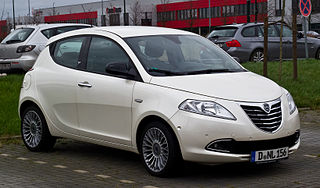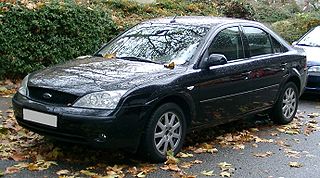
The Citroën C2 is a supermini that was produced by the French manufacturer Citroën, with production starting August 2003. It replaced the Citroën Saxo and was built at the Aulnay plant, on the outskirts of Paris. The Citroën C2 was discontinued in October 2009, and replaced by the Citroën DS3 in January 2010.

The Vauxhall Cavalier is a large family car that was sold primarily in the United Kingdom by Vauxhall from 1975 to 1995. It was based on a succession of Opel designs throughout its production life, during which it was built in three incarnations. The first generation of Cavalier, launched in 1975 and produced until 1981, was Vauxhall's version of the General Motors 'U-Car' - essentially an Opel Ascona B/ Opel Manta with a few minor visual differences.

The Fiat Croma name was used for two distinct large family cars by Fiat, one a five door liftback manufactured and marketed from 1985 to 1996, and after a nine-year hiatus, a crossover station wagon manufactured and marketed from 2005 to 2010.

The Fiat Tipo is a compact car, designed by the I.DE.A Institute design house, and produced by the Italian manufacturer Fiat between 1988 and 1995.

The Rover 200 Series, and later the Rover 25, are a series of small family cars that were produced by British manufacturer Rover from 1984 until 2005.

The Fiat Tempra is a small family car produced by the Italian automaker Fiat from 1990 to 1996 in Italy. The Tempra was intended as a replacement for the Fiat Regata. The original project was called Tipo 3, being a mid-size car between the Fiat Tipo and the bigger Fiat Croma. The Tempra shares its Type Three platform with the Lancia Dedra and Alfa Romeo 155.

The Fiat Punto is a supermini car (B-segment) produced by the Italian manufacturer Fiat from 1993 to 2018, spanning over three generations. The third generation of the car was marketed between 2005 and 2009 as the Grande Punto, and between 2009 and 2012 as the Punto Evo, until the single-word Punto name was reintroduced. As of May 2013, nearly nine million units had been sold globally.

The Fiat Bravo and Fiat Brava are small family cars produced by the Italian automaker Fiat from 1995 to 2003. They were effectively two versions of the same car: the Bravo, a three-door hatchback, and the Brava, a five-door fastback. The Bravo name was revived in January 2007, with the all-new Fiat Bravo, a replacement for the Stilo. The new version was available only with five doors.

The Renault 25 is an executive car produced by the French automaker Renault from 1983 to 1992.

The Fiat Stilo is a small family car available as a three- and a five-door hatchback, as well as an estate, produced by Italian automaker Fiat. The Stilo hatchbacks were presented in March 2001 at the Bologna Motor Show, and launched on European market in October 2001 to replace the Fiat Bravo/Brava, with the Stilo Multi Wagon following in January 2003.

The Renault 21 is a large family car produced by French automaker Renault between 1986 and 1994. It was also sold in North America initially through American Motors dealers as the Renault Medallion and later through Jeep-Eagle dealers as the Eagle Medallion. A total of 2,096,000 units were produced.

The Fiat Strada is a subcompact pickup truck (B-segment) produced by the Italian manufacturer Fiat since 1998. It is mainly produced in Brazil and marketed throughout Latin America, whereas the first-generation Strada was also assembled in South Africa and exported to Europe from Brazil.

The FIRE is a series of automobile engines from Fiat Powertrain Technologies, built in FCA's Termoli, Betim and also in Dundee, MI plants. It was designed by Italian design firm Rodolfo Bonetto. It is constructed by robot assembly plants ("Robogate") to reduce costs.
Multijet is Stellantis's term for its current common rail direct injection turbodiesel engine range. Most of the Fiat, Alfa Romeo, and Lancia range, as well as certain Chrysler, RAM Trucks, Jeep, and Maserati vehicles, are equipped with Multijet engines. Ownership of some Fiat Multijet designs is shared with General Motors as part of a settlement of the failed merger between the two auto conglomerates. The GM Powertrain Torino group in Turin, Italy, manages its interest in these engines. Some PSA Peugeot Citroën diesel engines are also rebadged JTD units, and vice versa. Fiat's common-rail diesel engine is also known as JTD, an initialism of Jet Turbo Diesel.

The Renault Safrane is an executive car designed and built by the French manufacturer Renault from 1992 until 2000. Throughout its production it remained the most expensive and most luxurious Renault available, although its commercial success was limited, compared to some similar models and also compared to its predecessor. Just over 300,000 Safranes were built, compared to nearly 800,000 Renault 25. It was replaced by the Vel Satis, and to some extent, by the short-lived two-door Avantime.

The Lancia Ypsilon is a supermini (B-segment) manufactured and marketed by Lancia, currently in its fourth generation and as of 2024, the marque's only model. The Ypsilon was released in 1995, as a larger and more expensive replacement to the Y10. Between 1995 and 2005, Lancia produced more than 870,000 Ypsilons in the Melfi plant in the Potenza region.

The Fiat Bravo is a small family car produced by Italian manufacturer Fiat from 2007 to 2014. It was introduced to the press in January 2007 in Rome, and later to the public in March at the Geneva Motor Show. A minor facelift was available from 2010, with changes to the front grille, door handles and side mirrors, new colors, as well as interior improvements. The car was launched on 21 April 2007.

The Ford Mondeo Mk3 (second generation) model was launched by Ford in October 2000. This Mondeo was considerably larger than its predecessor, and although Ford abandoned its New Edge design theme for the second generation, it was their first vehicle to fully benefit from the Prodigy concept car. This gave it an overall effect which many critics felt was more restrained and mature, if much less distinctive. Two of the old car's biggest weaknesses, the modest rear legroom, and uncompetitive diesel version were addressed by a 50 mm (2.0 in) longer wheelbase and the new Duratorq diesel engine. The basic chassis and suspension design was carried over from the previous generation, which meant that the car continued its predecessor's reputation for class leading handling and ride. This Mondeo came to Mexico, replacing the North American built Ford Contour, and was sold from 2001 to 2007, when the Ford Fusion replaced it. The North American market Fusion and Ford Five Hundred/Taurus sported very similar styling, inside and out.

The Fiat Pratola Serra modular engines are a family of engines produced by the Fiat Group since 1994 and used in Fiat, Alfa Romeo, Lancia and Jeep vehicles. They are named after the Pratola Serra municipality in which they're being produced.























